BIOGEOGRAPHY,
SYSTEMATICS AND PHYLOGENY OF THE BLOODFEEDING TERRESTRIAL LEECHES
OF THE INDOPACIFIC (OLIGOCHAETA: HIRUDINIDA: ARHYNCHOBDELLIDA)
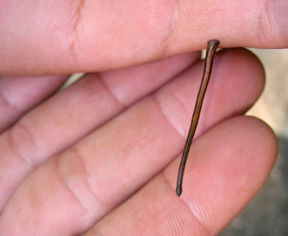
The focus of my dissertation is the biogeography, phylogenetics and systematic revision of the blood feeding terrestrial leeches of the family Haemadipsidae (Annelida: Oligochaeta: Hirudinida). There are approximately 52 currently recognized species in 17 genera (Sawyer, 1986), which traditionally have a strict geographic range in the Indo-Pacific (i.e. Madagascar, Seychelles, Indian sub-continent, IndoChina, Southeast Asia, and Australia). Thus, their distribution mirrors the breakup of Gondwanaland, which poses a very old origin for this group of leeches. Other leech taxonomists (Richardson, 1975) divided the haemadipsids by geographic region and by jaw morphology (2 - jawed or 3 - jawed) and proposed these groups be placed in their own families under a superfamily, Haemadipsoidea (e.g. Domanibdellidae, Haemadipsidae, Idiobdellidae).
There are a group of seemingly displaced terrestrial blood feeders found in isolated pockets around the world. These leeches can be found in the Southern European mountains (Xerobdella), Chile and South Africa (Mesobdella), Mexico (Diestecostoma) and the Juan Fernandez Islands (Nesophilaemon). These leeches were once classified in the Haemadipsidae, but there placement within the group had been problematic. Therefore, it was proposed by others (e.g. Ringuelet, 1953, 1972, 1982; Richardson, 1971, 1975) that they be removed from the Haemadipsidae and each be placed in their own respective families (i.e. Xerobdellidae, Mesobdellidae, Diestecostomatidae and Nesophilaemonidae).
This work will involve: a) fieldwork throughout their geographic range (including Chile, Madagascar, the Seychelles, Malaysia, Thailand, and Australia) to obtain vouchers for molecular work and the examination of morphology, b) the amplification and sequencing of nuclear and mitochondrial genes, c) using current phylogenetic methods to propose hypotheses regarding their biogeographic and evolutionary relationships, d) photo-documentation of type specimens in museum collections in Argentina, Australia, France, Germany, U. K. and Washington D. C. and d) a revision and re-description of species. All of which will be compiled into a monograph.
This work wouldn't have been possible without funding from the NSF- PEET grant awarded to Mark Siddall and without the collaboration of generous colleagues who collected specimens for us during their travels throughout the years.
PHYLOGENY
AND EVOLUTION OF ARHYNCHOBDELLIDA
(ANNELIDA: OLIGOCHAETA: HIRUDINIDA)
Leeches are divided into two major groups: the Rhynchobdellida (leeches that possess a proboscis) and the Arhynchobdellida, leeches that have a set of armed "jaws" that are used for feeding. The best known members of the Arhynchobdellida are the medicinal leeches (e.g. Hirudo medicinalis) and the blood feeding jungle leeches (e.g. Haemadipsa zeylanica). The arhynchobdellida are remarkably diverse in life history strategies ranging from being strictly terrestrial to being semi-aquatic blood feeders (Haemadipsidae and Hirudinidae), as well as being freshwater, amphibious or terrestrial carnivorous in habit (Americobdellidae, Erpobdellidae, Salifidae, Haemopidae). The most recent classifications of the Arhynchobdellida had underestimated the diversity of this group, dividing this group into seven families: Americobdellidae, Erpobdellidae, Salifidae, Cylicobdellidae, Haemadipsidae, Hirudinidae and Haemopidae (e.g. Sawyer, 1986).
This was my first major project on leeches that I started while I was Mark's scientific assistant. Here I learned how to use morphology and molecular data for phylogenetic work. Taxa included in this study were chosen to represent the seven currently recognized arhynchobdellid families (sensu, Sawyer 1986) with a global distribution. �Some of the major questions were to examine the phylogenetic placement of historically problematic taxa (i.e. Americobdella valdiviana, Mesobdella gemmata and members of the Cylicobdellidae), examin whether the traditional classification of leeches reflect their evolutionary history, and make inferences about the evolution of life history strategies, such as sanguivory and blood feeding.
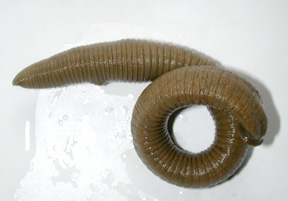
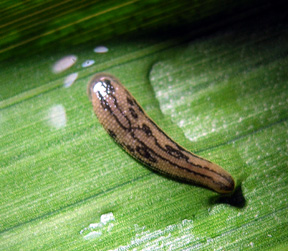
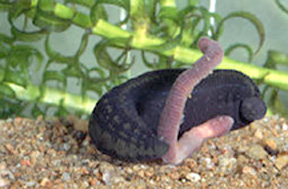
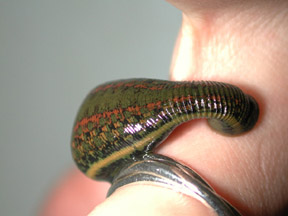
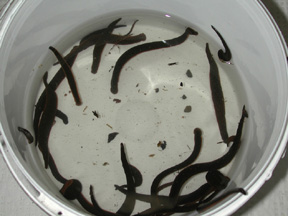
How did I get into this field?
As an undergraduate at SUNY at Stony Brook (1996), I participated in the Study Abroad Program to Madagascar with Dr. Partricia Wright, a primatologist. This was my first time conducting fieldwork and designing my own research project. I conducted a study on the effects of forest disturbance (i.e. clear cutting) on the diversity and composition of tree species and the feeding ecology of Propithecus diadema edwardsi (Milne Edward�s sifaka) in two sites in Ranomafana National Park, southeastern Madagascar. Since then I had developed an interest in field research and it was here that I had my first exposure to the blood sucking terrestrial leeches. At that time I had no idea this experience would come back to haunt me until I interviewed for a Scientific Assistant position at the American Museum of Natural History to work with Mark Siddall (2000), a curator and leech biologist. Since 2000, I have traveled around the world (see fieldwork) with Mark in search for leeches to gain a better understanding of their diversity and phylogenetic relationships.